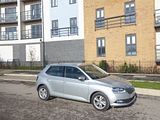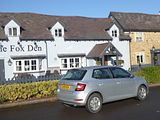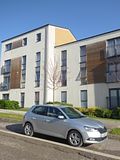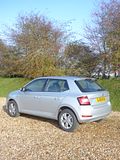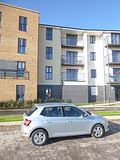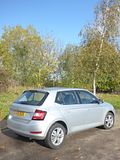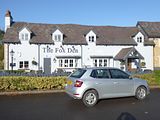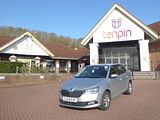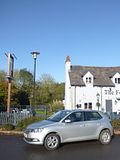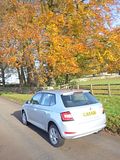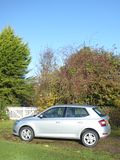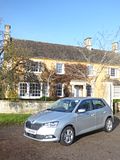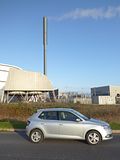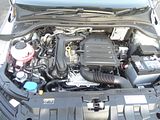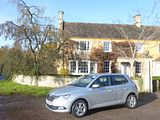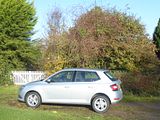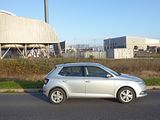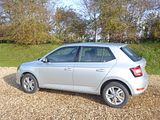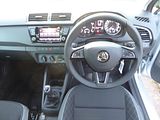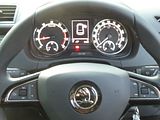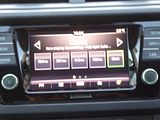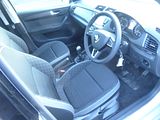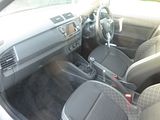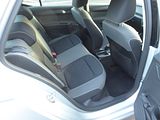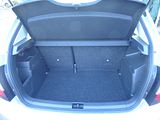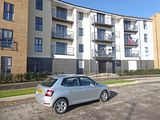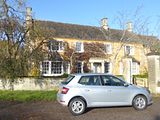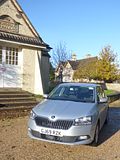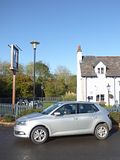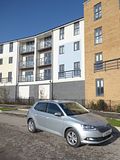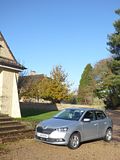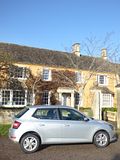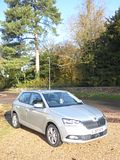A year ago, I had a week driving around in an example of Skoda’s supermini, the Fabia, and my conclusions were extremely favourable, as I declared that this was one of the very best supermini-sized cars that you can currently buy, with a combination of neat if slightly unassuming looks, a high quality finish, lively performance from the 3 cylinder 1 litre engine, and driving attributes which were both pleasant and held no surprises, as well as packaging which meant that there was decent space for passengers and luggage. Couple in Skoda’s value for money and excellent ownership attributes and the fact that there were no real weaknesses at all, and it was easy to rate this car as top of a very competitive class. Twelve months on, and I’ve had the chance to sample it again. Usually, when a rental car company – especially one with a large fleet of cars parked up ready for customers, such as Hertz’ operation at London Heathrow airport – allocates what is to all intents and purposes a “repeat”, I try to switch the car to something that I’ve not previously sampled, regardless of how good it is. And when I saw that a manual gearbox Fabia Hatch, in SE trim had my name on it, I did go and ask the question. The Hertz facility was absolutely rammed with cars, so I confidently expected that I would easily be able to get something different. But I was told that there was literally nothing else, and I mean not even the same car in a different colour, that was available to me. I asked why the “guaranteed” upgrade of one car class that Hertz commits to for its Presidents’ Circle members appeared not to have applied and what may have been a rather half-hearted effort by the counter agent yielded nothing. It was late and I was tired, so I took the Fabia, confident at least that I was getting a good car, and this one was very new with just 430 miles on the clock.
Closer inspection and a bit of research elicited that this car is not in fact identical to the one I drove in October 2018 in all respects but colour, as during 2018 Skoda applied a mild mid-cycle facelift to the Fabia, and the car I had in 2018 was prior to this, whereas this one had received the changes. As is often the case, the alterations made to the appearance are very subtle unless you know what to look for. The easiest way to spot a facelift car is that the rear bumpers now have the reflectors in them, whereas the earlier cars had them incorporated in the main light clusters. In fact the front has changed, too, with a reshaped grille and headlights. Look hard and you can indeed see the changes. One other difference between the two test cars was that this one was an SE spec car was the previous one had been an SE L.
Mechanically, the Fabia has not changed, so this car, just like the previous test car had the 1.0 litre 3 cylinder TSi engine which generates 95 bhp and driving it seemed to be very much as I recalled from before. You need a key in the ignition slot to start it and when you turn it, the characteristic sound of a 3 cylinder unit is evident. The engine is eager but not what you would call fast, though there is sufficient acceleration to allow you to keep up with the traffic flows. You do need to use the gears to get the best out of it and this car had a 5 speed manual gearbox. The ratios are well chosen and the quality of the gearchange is good, with the lever slotting into each gear with a nice precision. Whilst only having 5 gears is relatively unusual in his day and age, the reality is that this was not a problem, with fifth geared so that the engine was spinning at well under 3000 rpm on the motorway. Noise levels are generally well suppressed and the Skoda is a peaceful cruiser especially on the motorway. There is a Stop/Start system which cut in and out relatively smoothly. I failed to record details to declare the fuel consumption from this test but the 2018 test car achieved 43.68 mpg and I believe this car delivered something similar.
Whilst those who crave the very best levels of steering feel and handling from a car in the class will probably gravitate to the Fiesta and Mazda 2, the Skoda runs them fairly close. There is some feel to the steering and the car holds the road and corners tidily, allowing you to have some fun, though with “only” 95 bhp, there is not really enough power to get in to too much trouble. More importantly, perhaps, is the fact that the Fabia rides well, helped no doubt by the relatively skinny and high profile 185/60 R15 tyres. The brakes did their job as required, needing only modest pedal pressure to bring the Skoda to a halt. There is a conventional pull-up handbrake between the seats. Visibility is good, and there are rear parking sensors to help out. There is a small warning feature on the dash that tells you if you are too close to the moving car in front.
Inside the car, you will immediately notice a cabin of decent quality and decidedly unfussy in its design. Even in lowly SE spec, you get a leather wrapped steering wheel, gear lever and handbrake. The rest of the interior is made from high quality looking and feeling materials that belie the Skoda’s price. The instrument cluster comprises two large dials for speed and revs with smaller ones inset for fuel level and water temperature. There is a digital display area between the dials for trip computer and other functions, and the selection of what to show is made with buttons on the right hand steering wheel spoke. The buttons on the left hand spoke are for cruise control. There are two column stalks whilst the lights operate from a rotary dial on the dash, all of these being the same items as you find in pretty much every VW Group car at present. The centre of the dash contains the integrated touch screen which is used for audio functions, including DAB radio, and car settings. It is easy to use and Skoda have retained buttons and knobs for commonly used functions. Beneath this are he rotary dials for the air conditioning. Overall, the ensemble is neat and easy to use.
SE trim means cloth upholstery which had white stitching with a cross pattern in it which lightened the interior a little from a lot of black. Seat adjustment is all manual, with both driver and passenger having the benefit of height adjustment. The seat itself is soft and quite broad and I found it comfortable. There is a telescoping steering wheel, so I was able to get the driving position I wanted. There is plenty of space here, so even those with very different proportions to me should have no issues.
Space in the rear is reasonable. Any car in this class requires an element of compromise between the front and rear seat passengers, as with the front seats set well back there is not much legroom, but set them forward a little and those in the back seats should have enough space. They certainly should not lack headroom. Three adults would be a bit tight. There are plenty of places for odds and ends with bins on the doors, a well in the centre console and map pockets. Reminder that this is a cheaper trim comes from the manual rear windows and lack of a central armrest. The boot is deep but not that wide, and somewhat larger than that in most of its competitors. There is a space saver spare wheel under the boot floor and room around it for not a lot. More space is created by dropping down the asymmetrically split rear seat backrests, which gives a much longer load platform, The resulting space is more or less level. Inside the cabin, there is a massive glovebox, a well in front of the gearlever and there are pockets on the doors.
Skoda offer the Fabia with a choice of hatch or small estate bodies and a variety of different engine outputs, with the range starting now with a 75 bhp MPI engine, the lesser 60 bhp unit having been dropped and above this comes the 1.0 litre turbo 95 bhp of the test car and a more potent 110 bhp option. A diesel engine is no longer available in the light of falling demand. A DSG automatic gearbox is offered only in combination with the most powerful 110 bhp engine. As part of the mid-cycle update, Skoda improved the specification of the car. All models in the new range now feature LED daytime running lights as standard along with Front Assist and a Multifunction Trip Computer. Entry-level Fabia S models are priced from £12,840 OTR. This is very much a price-leading trim and most will consider it deficient in just a few too many creature comforts, with its wheel covers and lack of air conditioning though it does have a DAB radio with 4 speakers, accessed using a rather basic looking 5″ touchscreen and electric front windows as well as electrically adjustable and heated door mirrors. Customers stepping up to the SE model (from £14,115 OTR) can choose from all drivetrain options and gain front fog lights and 15-inch Cygnus alloy wheels over the outgoing model, along with Radio Swing Plus and auto up/down function for the electric windows. Other features carry forward from before and these include an upgraded six speaker audio system with a 6.5″ touchscreen which includes DAB radio, and Skoda SmartLink which enables Bluetooth, Apple CarPlay and Android Auto, height adjustment for the front passenger seat, an auto up/down function for the electric windows, a multi-function steering wheel, and leather wrapped steering wheel and gear lever as well as rear parking sensors and an alarm. Colour Edition models, priced from £14,665, gain 16-inch Vigo alloy wheels in white, silver or black. Customers opting for the SE L benefit from an even more significant equipment boost over the previous model. Priced from £15,205 OTR, Fabia SE L models now feature Amundsen satellite navigation, Infotainment Online (for one year), lighting in the front centre console and 16-inch Evora alloy wheels. These items are in addition to the outgoing Fabia SE L’s already comprehensive specification list which includes a front armrest, climate control instead of manual air conditioning and keyless starting. Priced from £16,785, the ever-popular Fabia Monte Carlo further enhances its reputation for sportiness with a range of new features. These include climate control air conditioning, LED rear lights, rear electric windows and new seat upholstery. The styling package includes a black front spoiler, black roof, black floor mats and carbon-effect dashboard trim.
I liked this Fabia, just as the previous example had also impressed me. Slightly surprisingly, perhaps, I’ve not driven any of its direct competitors in the interval between the two tests of this Skoda model, so have no recent experience to declare whether I would prefer any of its rivals. Popular opinion is that the Fiesta – in a new version since I last tested one – is still the best car in the class from a driving enjoyment point of view, but if you are looking for an overall ownership package which includes reliability, dealer quality and value for the money, then the Skoda still takes some beating. I think I would try to stretch to the SE L trim as there are some extra convenience features that are well worth having, but the SE is far from a stripped-out trim these days. And if the car rental firms offer me another Fabia as opposed to something I’ve not driven before, will I be upset? No, not at all. the Fabia is a good car that just gets the job done in true Skoda fashion.





